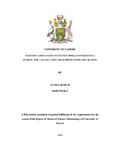| dc.description.abstract | Most socio-economic activities in Kenya are rain-dependent with the occurrences of
floods and droughts inflicting miseries at many locations year after year. Most of the
rains in Kenya are experienced within two major rainy seasons every year and are
centred on March-May and October-December. A third rainfall peak is observed at
some locations in western Kenya in June-August. The months of late December to
early February are however dry in most locations across the country.
The main objective of this study was to investigate the climate systems that may be
associated with extremely wet conditions that are sometimes observed during the
usually dry December-February (DJF) season in Kenya. The datasets used in this study
included monthly and daily rainfall data for 32 seasons from DJF 1981/82 to 2012/13.
Other datasets are wind downloaded from European Centre for Medium range
Weather Forecasting (ECMWF), historical tropical cyclone (name, track, and dates
they occurred), Sea Surface Temperature downloaded from National Oceanic and
Atmospheric Administration (NOAA), and Madden Julian Oscillation (MJO) proxy
values from Bureau of Meteorology (BoM) website. The data were subjected to
several analyses including percent anomaly and correlation analysis.
The results from the study indicated that during DJF, wet conditions are observed
during warm El Niño Southern Oscillation (ENSO) seasons regardless of the Indian
Ocean Dipole (IOD) phase though the intensity increases during a positive IOD phase.
The intraseasonal rainfall characteristics showed that although wet conditions spread
throughout the DJF season, the highest amounts of rainfall is received during specific
dekads. For example, during 1989/90 and 2012/13 DJF seasons, the rainfall received
during the third dekad of December accounted for 61% and 70% of the long term
mean respectively. These peak rainfall occurrences were associated with tropical
cyclones occurring in the South West Indian Ocean. This study further observed that
MJO’s contribution to rainfall during DJF of the ENSO neutral seasons is
insignificant. Results from this study provided information that can be used in water
use planning through water harvesting for irrigation, disaster risk reduction by
incorporating tropical cyclones in seasonal weather forecasting, among others in
support of sustainable livelihoods and national development. | en_US |

